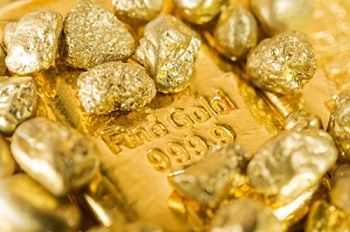How to Think Like a Gold Strategist (and Not a Researcher)
Posted on — Leave a commentRecently, John Reade, the Chief Market Strategist and Head of Research at the World Gold Council offered interesting insights on how gold research differs from strategy. Reade clarified that researchers are simply using all available data to understand the current state of the market. Examples include an analysis of supply and demand, mining operations or an individual countries market share.

Strategist, however, take analysis and run with it. “A strategist tries to think about how these moving parts fit together and which elements will change going forward,” remarked Reade. A researcher is delving into the delicious steak dinner while the strategist is thinking about dessert.
The distinction is important because it underscores the inherent uncertainty behind market prognostication. Moreover, it elucidates the symbiosis between the two roles. Research has little value without the ability to synthesize the findings. At the same time, a strategist is only as good as their basis of research. Of course, more research is not necessarily the answer.
“What I look at now is quite different from what I looked at 20 years ago, and different again from 10 and five years ago,” Reade continues. To effectively leverage the power of research a strategist need to become adept at distilling what matters from the “static.” Author and statistician Nate Silver explored this topic in depth with his New York Times best-selling book The Signal and the Noise.
In his book Silver takes issue with assumptions that rely too heavily on the clean, sterilized conditions of models that fail to factor for the differing levels of importance among the data used. That is, a strategist must understand what set of characteristics are more important among the group. Knowing where the signal lies reveals what data points can be safely muted. Yet, to find the needle you need the entire haystack. Therefore, greater historical data offers the promise of more needles.
Reade’s comments seem to echo Silver’s devotion to using a substantial set of measurements for isolating more accurate predictions. “This is another way in which strategy is different from research: the frequency of observations is higher, ideally in real time,” explains Reade. In following this practice, Reade outlines his data pools explaining that he looks at data from four key areas. Reade follows purchase levels, interest rates, macro-economic data and commodities like oil and even other precious metals.
Of course, while his process is enlightening, most of us simply want to know what the picture will be when all the puzzle pieces are together. After citing that long-term, real interest rates are low and that geopolitical risk is high Reade asserts that this “combined with concerns about the global economy will, in my view, likely see investors interested in gold.”
Being a good strategist starts with being a good researcher. Yet, a solid bank of data is only the beginning. The real trick is pulling what is germane to your question from the heap of otherwise unimportant, unintelligible “noise.”
Be a researcher first, then a strategist and finally an investor.
Markets Rip to New All-Time Highs
Posted on — Leave a commentFor what has occurred dozens of times so far in 2017, the stock market made another all-time high last week. Emini S&P 500 futures traded as high as $2,461.25 on Friday, with Mini Dow Jones Industrial Average futures making a fresh high of $21,628.

Markets seemed to love Fed Chair Janet Yellen’s dovish testimony last week that interest rate hikes might actually come slower than previously anticipated. This is partially due to the Fed interpreting retail sales and consumer sentiment data that came in below analyst’s projections.
For last week, all three major indices closed largely higher, marking the second positive weekly close in a row. Although the Nasdaq 100 did not make a new all-time high last week, it has almost fully recovered from the infamous and mysterious tech sell-off a few weeks ago.
Interestingly enough, the financial sector was the only declining sector in the S&P 500 on Friday. Despite JP Morgan (JPM) reporting positive Q2 earnings-per-share of $182, well above the projected consensus of $1.59, bank stocks, as a whole, didn’t exactly rally on the bullish news. Other consumer banking giants, like Wells Fargo (WFC) and Citigroup (C), strangely declined on upbeat earnings.
The energy sector contributed to much of last week’s gains in the overall stock market, as crude oil futures for August delivery were up more than 5% for the week. Reports of a possible setback in Nigerian crude supplies coupled with a recent forecast from the US Energy Information Administration calling for higher oil demand in 2017 drove prices noticeably higher.
Meanwhile, gold prices settled at the highest level in a month as the possibility of future interest rate hikes dwindled due to the aforementioned softer-than-expected economic data. Gold futures for August delivery climbed as much as $10.70, or 0.88% on Friday and ultimately settled at $1,227.50 an ounce.
Suffice it to say that economic data ruled the markets last week, as gold, crude oil, and stocks were all positively influenced.
Much of the buzz last week on Wall Street seemed to be focused on the CEO of JP Morgan, Jamie Dimon, and his unusual and expletive diatribe regarding the lack of growth in America when compared to other countries. During the earnings conference call for JPM, Dimon stated his frustration for US economic growth policies as a whole.
“I was just in France. I was recently in Argentina. I was in Israel. I was in Ireland. We met with the Prime Minister of India and China. It’s amazing to me that every single one of those countries understands that practical policies that promote business and growth is good for the average citizens of those countries for jobs and wages,” Dimon said to analysts and investors on the conference call.
He noted how growth policies in the US are not a republican or democratic issue. Rather, he noted how infrastructure and regulatory reform are the key to providing the much needed jolt to the US economy that would likely spur more growth in the stock market.
Later on this week, there is a Bank of Japan announcement on Wednesday, a European Central Bank announcement on Thursday, and a smorgasbord of earnings announcements as earnings season is officially in full swing. Another banking giant, Bank of America (BAC), is reporting earnings later this week and the current at-the-money option straddle is anticipating price movement in the stock, up or down, of 3.4%. Similarly, Johnson & Johnson (JNJ) is priced for a 2.4% move up or down. Both stocks are large components in the S&P 500.
Blanchard has successfully helped over 450,000 clients invest wisely in precious metals and rare coins throughout all of the ups and downs in the market. As always, our team of experts are here to help you make the right decisions and capitalize on opportunities in the precious metals market. Call us today at 800-880-4653.
Future Shock, All Over Again
Posted on — Leave a commentWriting in 1970, author Alvin Toffler remarked that “People of the future may suffer not from an absence of choice but from a paralyzing surfeit of it. They may turn out to be victims of that peculiarity super-industrial dilemma: overchoice.” His book became a modern classic. Future Shock warned readers of all the problems that occur when modernity outpaces our ability to adapt to changing times.

Now, decades later, his words ring true. The timelessness of gold has come head to head with the technological innovation of fintech solutions. This phenomenon has left some questioning how gold fits into the emerging world of digitized currencies like bitcoin.
Recently, The World Gold Council, released a report examining the future of gold amid the breakneck speed of blockchain technology. Interestingly, some experts believe that gold and the popular alternative bitcoin can happily coexist. “On 2nd March 2017, the price of BitCoin surpassed the price of an ounce of gold for the first time. For those who worry that gold has found a digital rival, it hasn’t – this is merely a nominal coincidence,” remarks The World Gold Council. They continue, “But gold also has an advantage – the market is deep (US$8 trillion) and it enjoys an unrivaled sense of security.”
This sentiment underpins an evolving perspective on gold. The emerging role of technology in our financial system only works to reaffirm the power of gold. It was the original form of universally accepted currency and still is. The authors of the piece from The World Gold Council remind readers that “Roughly US$250 billion changes hands each day through the gold market.” Moreover, the advent of technological developments may actually boost gold’s popularity.
Some have come to assert that people can leverage blockchain technology to hold a balance in true, tangible gold while still spending the asset. What’s more, this development would work to increase the liquidity of gold. With greater liquidity gold would become an even more agreeable way to invest cash and retain the value of one’s holdings. For these reasons experts are beginning to see the likelihood of a resurgence of gold increase.
Toffler was right about many things. However, the burden of choice may soon dissipate. Technology enthusiasts and gold holders just might have everything they want in one convenient choice.
Too often we assume that the new replaces the old. While, in some cases this is true, it’s far more common that the new reinvigorates the old. Or, as some have succinctly put it “everything new is old.”
Technology has found more efficient ways to put gold in the hands of investors. Meanwhile, unlike ETF solutions, new technology gives people a true claim to the asset rather than just a glorified promissory note. As this trend continues investors will see faster ways to make gold part of their holding all while knowing they can access it at any time and convert its growth into true spending power. As the authors explain, “In an indebted world, there are plenty of reasons why people should want to carry electronic gold in their pockets – and technology is allowing them to do so in a seamless way.”
Gold Tumbles to 4-Month Low on Strong Jobs Report
Posted on — Leave a commentThe gold market took a dive last week, hitting a fresh four-month low following a stronger-than-expected U.S. jobs report. Gold touched a low at $1,207.00 per ounce.

The Labor Department said 222,000 new jobs were created in June, which beat economist’s expectations of a 174,000 gain. That follows strong labor reports in May and April and signals robust job growth.
The gold market has turned down since early June in a summer slide. That offers long-term investors a better entry purchase point. Short-term gold traders are exiting positions amid continuing signs the Federal Reserve will continue its plan to increase interest rates this year and next. Also, a lack of significant geopolitical turmoil or economic distress has removed some safe-haven demand from the gold market this summer.
While gold bears control the short-term trend, longer-term investors view the price dip as essentially offering up gold and silver “on sale.” The gold market is approaching a technical chart support zone at the $1,200.00/$1,190.00 area which could act as a hook to stabilize the market and act as an attractive entry point for investors with a long-term time horizon.
Gazing Into the Crystal Ball
Wall Street anticipates one more interest rate hike this year – at the December meeting.
The strong jobs report last week also gives the Federal Reserve an added kick toward beginning its balance sheet reduction, sooner rather than later. There are four upcoming Fed meetings in 2017.
Remaining 2017 FED Meetings
Date Market Expectations of Rate Hike*
July 25-26 3.1%
Sept 19-20** 18.4%
Oct 31-Nov 1 19.7%
Dec. 12-13* 50.6%
(* per CME FedWatch data tool, **meeting with a press conference)
$1400 Gold – All Bulled Up
Despite the modest Fed interest rate increases expected ahead, Wall Street firms remain bullish on the prospects for gold ahead. In a new research report published at the beginning of July, BofA Merrill Lynch Global Research forecasts gold at $1,400 an ounce in the first quarter 2018 and silver to rise to $20.71 per ounce in the same quarter.
“We believe markets are somewhat too complacent and investors should build positions in volatility-exposed instruments. Broadly, we believe that there are various alternatives to protect portfolios against increasing policy risk and a rapid reversal in investor positioning. Investors could opt to increase their gold allocations,” according to the BofA Merrill Lynch Global Research report.
The Bottom Line
Current levels in gold and silver offer long-term investors an attractive buying opportunity. Over the past 40 years, Blanchard has helped clients invest in American numismatic rarities and gold, silver, platinum, and palladium bullion. Contact us at 1-800- 880-4653.
The Stock Market is Doing Something it Hasn’t Done in 14 Years
Posted on — Leave a commentLast week was another interesting week for markets in the US, to say the least. With shortened trading due to the Independence Day, volatility and trading activity were both expected to be lighter than normal.

For the most part, the holiday trading activity expectation was indeed true, until Thursday rolled around. Stocks took a violent beating on Thursday with the S&P 500 leading declines for the day, followed by the Dow Jones Industrial Average and Nasdaq 100. A whopping 27 out of 30 total companies in the DJIA closed in the red on Thursday leaving the index with a triple digit loss of 158.13 points, or 0.70%. The Dow’s decline, however, was overshadowed by the S&P 500’s stark loss of nearly 1% to close at $2,409.75.
The declines came on the heels of a mix of geopolitical worries, continued tech selling, and weaker than expected economic data. On the geopolitical front, news agencies reported renewed missile test launches from North Korea that seemed to cause a “risk off” trade among investors.
For economic data, ADP payroll data also contributed to the declines on Thursday, as the actual number of 158,000 new jobs was well short of the expected 180,000. In addition to the North Korean news, this seemed to be enough to cause investors to taper their long positions.
However, despite Thursday’s harsh declines, all three indices posted a strong rally on Friday as the US Department of Labor reported 222,000 new jobs for the month of June, completely beating most of the expectations on Wall Street.
The stellar jobs report was not helpful to the gold market, however, as the data solidified the path for the Fed’s current interest rate hike agenda. The yellow metal was off more than 1% upon release of the monthly jobs data, yet it still managed to hold its ground well above $1,200 per troy ounce.
Although employment data was surprising last week, the real phenomenon that had traders scratching their heads was the historic lack of correlation between the three benchmark indices.
For the first time since 2003, the correlation between the DJIA and the S&P 500 slumped to a low of 0.4655. A correlation of 1.00 is perfectly correlated and means two assets move entirely in sync, and a correlation level of 0.00 is entirely not correlated and implies two assets move independently. The fifteen-year average correlation for the two indices is 0.9557, which is almost perfectly in synch.
Basically, for the past 20 trading days, the Dow and the S&P have been trading almost entirely in their own worlds, only moving in the same direction less than half of the time. So what’s driving this rare lack of correlation in the markets?
“The disconnect is probably due to the tech stocks, because some of the biggest companies are tech stocks but not many of them are in the Dow Jones,” said Randy Frederick, managing director of trading and derivatives at Charles Schwab. This explanation makes sense, but it is not particularly southing news for investors. With inexplicable sector-wide sell-offs and low correlations in the most well-known and liquid market in the world, many investors don’t know what to expect next. Because of this, safe haven assets, like volatility and gold, are looking more attractive day by day.
Open interest data confirms the unknown buyer of $3.8 million worth of VIX call options, as mentioned in previous articles, has yet to cash out on the trade despite several large spikes in volatility. Could more unexpected and unusual market moves be lurking around the corner? Only time will tell.
As if the 14-year slump in broad market index correlation didn’t provide enough mystery for the week, silver futures suffered an extremely bizarre “flash crash” during late trading on Thursday. Silver futures for September delivery cratered more than 10% from $16.13 per troy ounce to $14.34 in only a few short minutes. With no explanation for the plunge other than an “accidental trade,” the monumental decline was instantaneously reversed and silver was back near $15.80 per ounce. All of this took place in less than five minutes.
The flash crash in silver is the perfect example why owning physical precious metals is demonstrably safer than owning precious metals electronically. If an investor had a -10% stop-loss for a long silver position, Thursday’s flash crash would have instantly caused an irrecoverable 10% loss.
Between flash crashes, nuclear missile tests abroad, and a historic level of low correlation in the largest equity market in the world, it’s safe to say the past few weeks have been home to some of the most unusual trading activity in the past decade.
For over 40 years, Blanchard has helped over 450,000 clients invest wisely in precious metals and rare coins throughout some of the most bizarre market conditions imaginable. As always, our team of experts are here to help you navigate the markets and capitalize on opportunities amidst the chaos. Call us today at 800-880-4653.
The Science behind Money and Happiness
Posted on — Leave a commentIt’s the age-old question. Can money buy happiness? While conventional wisdom says no, researchers are upending traditional thinking here.

It turns out how you spend your money can impact your happiness levels, according to research from Harvard Business school professor Michael Norton. People who spend money on experiences – not things – brought higher levels of happiness.
Adding in another layer of research, the further that people think and plan ahead for their future, the higher levels of power and happiness they feel in their lives, according to a Morningstar report by behavioral economist Sarah Newcomb Ph.D.
The key takeaway: Creating economic stability now and in the future helps people achieve higher levels of emotional well-being.
“According to the American Psychological Association, year over year, money is the number one source of stress in U.S. households, regardless of the economic climate. Given that stress leads to health problems, lost productivity, relationship problems, and an overall loss in quality of life, it’s clear that the emotional aspects of a person’s financial life are a critical part of their overall financial health,” the Morningstar report said.
Here are key findings from the Morningstar report:
- Time is money – The further ahead a person thinks in time and the clearer their picture of the future, the better their behavior in terms of cash, credit, and savings management. This effect was significant even when controlling for income, age, education, and gender.
- Power is happiness – Across all income levels, people who believe they create their own financial destiny experience, on average, display more positive emotions with respect to money than their peers who believe they do not have power in their financial lives. The effect of perceived power on emotional wellbeing was greater than that of income, age, education, and gender.
Focus On What You Can Control
When it comes to finances and investments there are aspects that you can control and variables that you cannot control. Focus on what you can control. Here are some examples of factors you can control:
- The $ amount that you save each month.
- The types of assets that you buy.
- How well you diversify your portfolio.
Financial advisers suggest saving and investing different percentages of your income. Some may point to 5%, while others may say saving 20% of your income is a better target. When it comes to building long-term wealth and saving for retirement, you probably won’t run into the problem of saving too much.
Take the time now to think about your long-term financial goals. Write them down in detail. Then, develop a plan to help you get there. There are investors who purchase a set amount of gold and silver assets each month, as part of a dollar-cost-averaging plan. Just as you might divert a certain amount of your income to the stock market each month, diversify your portfolio with investments into gold and silver.
Gold and silver are proven portfolio diversifiers and also act as a vehicle for long-term wealth building. Boost your happiness levels now and in the future by taking control of your financial life and building an investment plan. A Blanchard portfolio manager would be happy to work with you to discuss your long-term goals, your level of risk tolerance and help you create a plan to move your closer toward your dreams.
Bizarre Week for Markets
Posted on — Leave a commentThe S&P 500 and Nasdaq 100 just had one of the most volatile weeks of 2017. To recap, stocks opened up largely higher on Monday of last week before inexplicably declining to finish out the day. Tech shares sold off dramatically, for the second time, on Tuesday and dragged many large-cap stocks along for the ride.

Investors evidently took advantage of Tuesday’s sell-off and bought the dip on Wednesday. The S&P 500 had its third best day of 2017 on Wednesday as it rallied almost 1% while the Nadsaq 100 was up nearly 1.5%. History tells us that when stocks have such a strong rally, it’s not uncommon to see the rally extend for several more days. This is especially the case when stocks close at the high of the day, as they did on Wednesday.
After the market closed on Wednesday, the Federal Reserve announced that every major bank, except for Capital One, passed their “stress test” and had more than enough cash on hand to withstand adverse economic conditions. As a result, banks rushed to announce shareholder buybacks and increased dividends.
Bank stocks rallied tremendously after hours and pushed the S&P 500 and Dow Jones Industrial Average up around 25 basis points (0.25%). The rally held right up until Thursday morning when the Nasdaq began declining sharply due to weakness in tech stocks. The selling didn’t stop and S&P 500 futures plummeted from $2,445.00 to $2,402.75 before rebounding 20 points to close out the day.
However, the real focus was on volatility. Because of the sharp and relentless decline in stocks on Thursday, the VIX soared over 40% and peaked at 15.16. The mysterious volatility buyer mentioned in last week’s article, who purchased over $3 million worth of VIX premium, saw almost a three-fold profit on the risky trade.
Needless to say, market participants were scrambling on Thursday. Although the Nasdaq was off more than 2.5%, the S&P didn’t even come close pushing past the 2% mark.
“When you get extended rallies, the kind we saw in technology shares, prices tend to come down a lot faster. Though, when markets drop 1%, it’s hardly a selloff,” said Joe Saluzzi , partner, co-head of equity trading at Themis Trading.
“It is still perplexing to see the stock market climb to highs when the bond market is signaling a slowdown. One of these markets is not right,” Saluzzi went on to say.
Regardless of where market participants think the market will go in the coming months, the dynamic has undeniably changed. For the first time since the November 8th election, sell-offs are occurring more frequently and with far more velocity. Enough velocity, in fact, to get a spike in the VIX of 40%, which is not trivial.
Unusual market moves also occurred in the precious metals realm last week. Early Monday morning, when liquidity is typically less than during normal market hours, a massive order to sell 1.8 million ounces of gold took prices down nearly $20. Many brokers and CTAs chalked the order up as a “fat finger” trade, which is trader jargon for an accidental trade. Gold recovered relatively quickly after the massive order but finished out the week with a bit of a whimper beneath the key level of $1,250 per ounce.
Trading was shortened this week by the Independence Day holiday yesterday, so volume and activity is expected to be lighter than normal for the remainder of the week. Liquidity, or the number of people willing to buy and sell securities at specific prices, will also be lighter than normal. Judging by last week’s activity, it wouldn’t be unusual to expect more volatility in the coming weeks with less liquidity due to summertime.
How to Airlift 214 Tons of Gold
Posted on — Leave a commentThere was no time to weigh the gold, the total was estimated on the fly. It was 1967 and people were frantic. The US Treasury was loading a Starlifter, a massive army transport capable of flying payloads of more than 60,000 pounds. This is what it looks like when the US Government makes the single largest outgoing gold delivery in history.

Several flights were needed to complete the transfer. Each plane carried $100 million worth of gold. Every flight landed at a Royal Air Force base in the UK. The final destination was The Bank of England. “Panic reigns in the gold market,” wrote one Treasury official.
The delivery of gold to the UK was a response to surging gold purchases following a devaluation of the British pound. The Bank of England was unable to satiate the mounting demand. People were losing faith in England’s currency. Other economies, like Japan, began to show signs of weakening support. Gold purchases increased further boosting prices even more. In his recent book One Nation Under Gold, James Ledbetter explains “the volume of gold traded nearly quadrupled.” What happened next? “That was when The Bank of England told the US Treasury that it could no longer back up the markets daily transactions.” Eventually, the US decoupled gold and the dollar.
The dollar became the “mechanism of exchange.” Today, this is hardly shocking or even interesting. However, at the time, amid such uncertainty, Americans were ushering in a new era where the economy changed nearly overnight. This was something different. Ledbetter astutely remarks that while FDR did take the U.S. off the gold standard earlier in the 1930s, there was still a mandatory stock of gold supporting the dollar. This practice was not an abstraction. There was a vault. There was a key. Suddenly, this wasn’t the case.
Meanwhile, for a period, Americans were restricted by law from owning gold. This limitation only added to the already pervasive sense of unease. How does one protect their assets from the inherent problems with a paper currency backed only by confidence? Many turned to pre-1966 silver coins. They hoped the rising value of the metal would buoy their assets against another crisis.
Not until 1974 would Ford permit Americans to own gold. However, the market has taken an interesting turn since those days. Today’s investors have exposure to numerous methods for owning gold that, somewhat ironically, are reminiscent of the anxieties of an earlier time. Products like gold ETFs make ownership easy but put no real metal in the investor’s hands. What’s more, investors of these instruments have no claim to the physical asset. Starting to sound familiar?
Too often these kinds of investments only serve to make the individual feel like they own gold when in fact their owning paper and sometimes not even that. Too many embrace these modern solutions while forgetting their resemblance to an era when people had no real cover for their assets. Fortunately, the savvy gold enthusiast still has places to go to own the real thing.
Is Another Housing Bubble Building?
Posted on — Leave a commentFrom the tulip bubble in the Dutch Republic in the 1600’s to the South Seas bubble in the Great Britain in the 1700’s to the Dot.com mania in 2000, history is littered with bubbles. They have one thing in common – they always pop.

If you or anyone you know has been house-hunting lately, you are well aware of the “tight inventory” situation. There’s more buyers than there are houses right now, and that is pushing home prices higher.
While investors often get sidelined by vacations, lazy weekends at the beach, and spending time with friends and family during the summer months, there are underlying economic developments that bear watching.
Remember 2005?
Developments in the U.S. housing market have some economists hearkening back to the housing bubble that occurred about a decade ago. Within the new home arena, the impact is startling. The Fed’s still ultra-low interest rate policy, combined with the relative lack of supply have sent new home prices soaring.
The median new home price has skyrocketed 16.8% over the last year to $345,800, which is an all-time record high.
“Housing inflation is back, big time,” says Chris Rupkey, Chief Financial Economist at MUFG Union Bank, N.A. “This home price appreciation is certainly as rapid as it was during the housing bubble years and just as worrisome. The collapse of housing prices helped make the Great Recession great so we hope the Fed knows what it is doing,” Rupkey warned.
“Home prices are on fire with a new bubble in the making,” Rupkey warned. “Home price inflation isn’t going to stop either until the Fed starts moving up interest rates at a faster pace. The Fed says it cannot move up interest rates more quickly because ‘the natural rate of interest’ remains low, still encountering headwinds from the recession, but there is nothing natural about the rate of home price appreciation. It’s outasight.”
Moving to the high end of the real estate arena, the ultra-wealthy have been snapping up New York City condos like hotcakes. Another market commentator warned that a real estate bubble is in the works pointing to these examples in the high-end luxury market in Manhattan:
In 2014, the first New York City condo was sold for more than $100 million at One 57.
The cost was reportedly, $9,136 per square foot in 2014. Last year, however, in 2016, a swanky 16-bedroom penthouse at 220 Central Park was listed for $250 million. A deal or a bubble?
Before the next housing bubble in the U.S. has negative spillover impact on the broader economy and the U.S. stock market, take the time to properly diversify your portfolio and protect your assets with gold and silver.
Market Update: Gold Sees Modest Weekly Gain, Buyers Emerge On Dip
Gold prices closed slightly higher on a weekly basis on Friday. Buyers once again emerged as gold dipped toward the $1,242.00 an ounce level mid-week. Investors continue to wait in the wings and are buying gold and silver on price retreats.
The trend remains bullish for gold and other precious metals. Although the summer doldrums has seen quieter activity, gold is nearly matching the stock market’s gains year-to-date. Gold is up 8.32% through late June, versus the S&P 500’s gains of 8.91%.
For historical reference, gold investors may be interested to know that the price of gold climbed from $451 an ounce in 2004 to over $1,900 an ounce in 2011. Current prices in gold around $1,240 an ounce offer extremely attractive buying opportunities relative to the all-time high.
Is a Sell-off Coming? One Mystery Investor Thinks So
Posted on — Leave a commentUS equities came out of the gates running last week by starting with a firm rally across the board on Monday. The S&P 500, Nasdaq 100, and Dow Jones Industrial Average were all largely in the green as the tech sector gained substantially. Most of the gains were driven by the largest company in the world by market capitalization, Apple, as the computer giant announced plans to develop an augmented reality app that enables consumers to virtually test furniture from home before they make a purchase.

Evidently, the news was enough to excite investors and the S&P 500 hit a fresh all-time high during Monday’s trading. Nevertheless, stocks managed to give back some of their gains later in the week with softer than expected economic data and weak crude oil prices.
However, slight weakness in domestic equities was drastically overshadowed by weakness overseas. The benchmark FTSE 100 index finished in the red for four straight sessions ending last week with a loss of 0.50%. Overall, the index has fallen for three consecutive weeks, which is the longest stretch of losses for the index in a year.
Essentially, much of the weakness in global stocks can be attributed to the relentless dive in the price of crude oil. Crude oil prices directly affect both European and US energy companies.
“The enormous volatility in the oil market is unsettling investors around the world. The fear of falling inflation and reduced growth prospects is at the forefront of traders’ minds. It is not unusual for us to witness rallies, but the big picture is that oil has been falling since March, and now the selloffs are becoming even more severe,” said CMC Markets analyst David Madden in a note to clients.
Because the energy industry represents a significant portion of bedrock companies in the US and Europe, it’s difficult to have rallies when the entire sector has plummeted 15% YTD.
The plunge in oil prices even has some traders wondering if it will alter the Federal Reserve’s rate-hike agenda. But a fixed income strategist for BMO Capital Markets noted how “the Fed doesn’t respond to it much because oil is so volatile.”
At this point, it’s unclear if oil inventories will continue to rise and prices will continue to fall, despite OPEC’s concerted efforts. If prices continue to slide, it’s not unreasonable to see further weakness in markets around the world.
Along those lines, one mysterious investor is particularly bearish in the next couple of months. On Tuesday of last week, an unknown investor purchased $3.8 million worth of VIX call options. The large trade of 74,300 contracts had everyone on the Street buzzing, because the trade will only pay off if there is a stark decline in asset prices and a huge pop in volatility.
Basically, there will need to be somewhat of a stock market crash between now and mid-August when the options are set to expire. Otherwise, the options will expire out-of-the-money and be completely worthless and the $3.8 million will be fully lost.
Because of the large size of this trade, many investors are wondering if the mysterious buyer of volatility knows something that other people don’t. Regardless, if there is a large increase in volatility and the VIX due to an unexpected market plunge, gold arguably stands to benefit just as much as the call options, if not more. And, unlike the calls purchased last week, gold won’t expire worthless if nothing happens in the next two months.
Therefore, gold truly is one of the better investment vehicles of this generation, because it serves as a prudent investment and a hedge against a market catastrophe.
For over 40 years, Blanchard and Company has helped over 450,000 clients invest wisely in precious metals and rare coins. Call us today at 800-880-4653.








